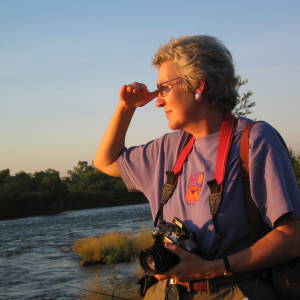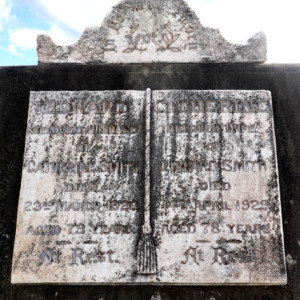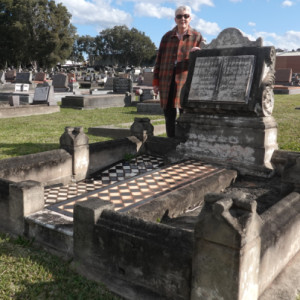He chased Ned Kelly . .
. . . and today I found his grave (see extras).
When I was growing up my father used often to tell us stories about how his grandfather had chased Ned Kelly, the notorious and violent bushranger who is deeply woven into Australian folklore. My father was a bit of a larrikin and it wasn't beyond him to spin a few yarns. Our reaction was "Oh yeah Dad. Tell us another one." "No, no. It's true" he would reply. "Sure, Dad".
Last year, I learned that Dad was right.
This is a photo of my great grandfather, Edward Hayden Smith with his wife, Catherine, and some of his children. My grandfather and his twin brother were their eldest children and are not in this photo. Perhaps they were out at work.
In 1878 Senior Constable Edward (Ned) Hayden Smith was stationed at Corowa, a small town on the New South Wales side of the NSW/Victoria border. By then Ned Kelly was the most wanted man in Australia. On 26 October 1878 the Kelly gang shot and killed three policemen at Stringybark Creek, near Mansfield, Victoria. The authorities believed they would attempt to flee across the River Murray to New South Wales, and large numbers of Victorian and New South Wales police were marshalled to guard all possible crossings of the river. The task was made the more difficult by record rainfall and flooding.
On 31 October Neil Christian, a farmer from Bungowannah in NSW, reported to the Chiltern police that he had been “stuck up” by the Kellys the previous day. Police from Rutherglen, Wahgunyah, Corowa, Howlong, Albury, Beechworth and Chiltern were ordered to close in on the Murray near the Baumgartens’ property at Barnawartha, about 35kms from Bungowannah on the Victorian side of the river.
Senior Constable Edward Smith and Constable Lawrence set off on horseback from Corowa that night in heavy rain. At Howlong they approached a group of police near the Howlong cutting with the intention of exchanging intelligence. These other police, however, mistook them for members of the Kelly gang and fired several shots at them. Fortunately, no one was hurt, and the two groups combined and continued to watch the crossing. There was no sign of the Kellys and Senior Constable Edward Smith and Constable Lawrence returned to Corowa on the Friday night after 36 hours in the saddle in continuing heavy rain.
This story evidently gained continuing currency, and in 1883 an expanded version of it appeared on 12 October in the ‘Gundagai Times’. Apart from erroneously placing it in March, this account added further detail, dialogue and some humour. It changed the identity of Senior Constable Smith’s companion.
"When the Kelly scare was on, police in large numbers were ordered to patrol about the Murray District in plain clothes. One cold March night, at Howlong, a company of 11 police were waiting and watching for the Kellys, and about 10 PM their anxiety was rewarded by seeing four men come over the bridge. A constable named Frank Larkins was in charge of the force assembled, and he was known to the Kellys, and was usually addressed by them as “Frank”. The men coming over the bridge could be just discerned in the moonlight, and they had the appearance of being armed. To make matters worse, the bridge fence had been newly painted, and this caused the horses of the four men to shy, and suggested the idea that the men were trying to bolt. Immediately the police saw these men they were called upon to stand, but the only reply was “It’s all right, Frank”. This only increased Constable Larkins’s suspicions, and he ordered his men to fire – he himself firing the first shot, which went close to one of the supposed bushranger’s face. “For God’s sake, stop, Frank; it’s Ned”, said one of the men. “I’ll Ned you”, was the reply, thinking only of the redoubtable “Ned Kelly”, and bang went another rifle. Just as the second shot was fired, it struck the attacking party that they had fallen into ambush, and that the Kellys were in possession of Howlong, and they decided to fire on the enemy, when some of the force said, “Why, that’s old Ned Smith, of Urana”, and the firing ceased, thus probably saving two of the best police officers known to the Gundagai residents, viz, Senior - Constable Edward Smith of Jugiong, and Constable Dixon, Gundagai."
My great grandfather never caught Ned Kelly. That finally happened at a shootout at Glenrowan in June 1880 which ended the Kelly’s activities. But Dad was right and oral history wins again.
Today we had to go to Wollongong for an appointment. We took the opportunity to visit the old Wollongong Cemetery and, to our delight, found the grave of my great grandfather and great grandmother.
The second extra is yours truly proudly standing near their grave.



Comments
Sign in or get an account to comment.


